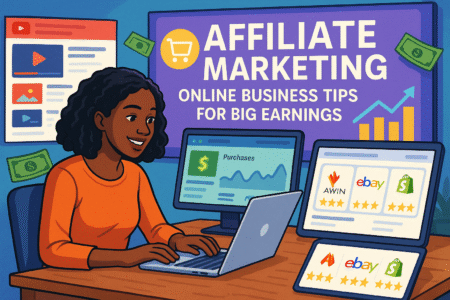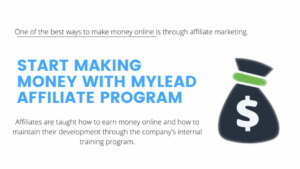Table of Contents
Looking for the best ways to do affiliate marketing without ads? Maybe you’re tired of spending money on Facebook or Google campaigns that don’t convert. Or you’re just starting out and don’t have a budget for paid traffic yet. Either way, you’re not alone—and the good news is, you can absolutely succeed without running a single ad.
What if you could earn commissions while growing a blog, building an email list, or creating content that keeps working for you 24/7? How do people actually make money in affiliate marketing without relying on expensive ads?
In this guide, you’ll discover proven, practical strategies that show exactly how it’s done—no ad spend required. Let’s dig in.
Build a Niche Blog That Solves Real Problems
Starting a niche blog is one of the most sustainable and powerful ways to succeed with affiliate marketing without relying on ads. But success comes from choosing the right niche and solving real problems, not just writing random content.
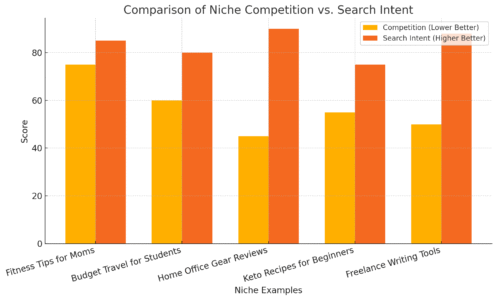
Choose a High-Intent Niche With Low Competition
Let me break it down for you: the sweet spot lies in finding a niche where people are actively searching for solutions but not overwhelmed by big competitors. High-intent niches have audiences that are ready to act—whether that’s buying, subscribing, or solving a problem.
Here’s what to look for when choosing a niche:
- Search queries that include action words like “best,” “review,” “how to,” or “for beginners.”
- Forums and subreddits filled with real questions (indicating interest but possibly under-served content).
- Keywords with low difficulty (KD < 35) but good monthly search volume (over 500).
For example:
- “Home office gear reviews” is a low-competition niche with strong purchase intent.
- “Freelance writing tools” targets people actively looking to invest in their work.
The chart above shows a few examples of niches plotted by competition and intent. A good niche scores low in competition and high in search intent—your goal is to land in that quadrant.
Create Deep, Evergreen Content That Drives Organic Search
Evergreen content stays relevant. Think product reviews, comparison guides, tutorials, and FAQs—these are posts that bring traffic months or even years after publishing.
Here’s what I recommend:
- Use tools like AnswerThePublic or PeopleAlsoAsked to find recurring questions.
- Turn one blog idea into multiple: a detailed guide, a checklist, and a comparison post.
- Make your content skimmable but packed with insights. Subheadings, images, and examples help keep readers engaged.
Google rewards helpful, in-depth posts. If your content answers user questions better than what’s already out there, your post will climb the rankings naturally.
Use Internal Linking to Boost Affiliate Page Rankings
Internal linking isn’t just about helping readers—it’s a powerful SEO move. When you consistently link to your affiliate-focused pages from supporting articles, you pass authority to them, signaling to search engines that those are important.
Here’s how you can structure it:
- Link from top-of-funnel content (like “best standing desks”) to bottom-of-funnel pages (like “Flexispot E7 Review”).
- Use natural anchor text instead of forced keywords.
- Create a content hub where all posts point to a central affiliate landing page.
A well-linked blog flows like a web, guiding readers through a path toward conversion—without sounding salesy.
Optimize for Search Intent, Not Just Keywords
It’s easy to chase keywords, but it’s smarter to focus on what the user actually wants. A post targeting “best email tools” should compare platforms, not just list features.
Ways to better match search intent:
- Look at the top 3 ranking pages—what format do they use? Product list, tutorial, guide?
- Mirror what works while improving the depth or freshness.
- Focus on providing the exact answer users came for—and then offer your affiliate solution naturally.
The best ways to do affiliate marketing start with understanding your reader. Serve their needs first, and the clicks will follow.
Start a Targeted Email Newsletter From Scratch
Email is still one of the most effective ways to build trust, share affiliate products, and make sales—without paying for traffic. Starting with the right offer and structure can make a massive difference.
Offer a Valuable Freebie to Build Your Email List
To grow your email list from zero, you need an irresistible reason for someone to sign up. That’s where a freebie or lead magnet comes in.
Some proven ideas:
- “10 Best Tools for X” guide with affiliate links inside
- Free email course on solving a problem your niche faces
- Notion or Google Sheet templates related to your content
I’ve seen niche bloggers 10x their sign-up rate just by switching from “join my list” to “get this free toolkit.”
Segment Your Audience Based on Their Interests
Once people are on your list, treat them like individuals. Not everyone will want the same affiliate products, and that’s where segmentation helps.
You can segment by:
- What freebie they signed up for
- Which links they’ve clicked in past emails
- Interests they selected during signup (use a form with checkboxes)
Tailored emails perform better—higher open rates, more engagement, and better conversions.
Use Storytelling in Emails to Drive Affiliate Conversions
Dry product pitches rarely work. But sharing a short story or personal experience before introducing your affiliate link can completely change the result.
Here’s a structure I’ve found effective:
- Start with a relatable challenge (“I struggled with keeping my productivity on track…”)
- Share a personal solution or transformation (“That changed when I discovered [product]…”)
- Add a call to action with your affiliate link (“I still use it every day—check it out here.”)
Authenticity builds trust. It’s one of the best ways to do affiliate marketing without sounding like a salesperson.
Track Clicks and Open Rates to Optimize Campaigns
If you’re not measuring your email performance, you’re flying blind. Use your email service provider’s built-in analytics to track:
- Open rates (Is your subject line working?)
- Click-through rates (Are people interested in your link?)
- Unsubscribes (Is your content still providing value?)
Over time, you’ll start to see what topics and products resonate most. Focus more on those and refine the rest. This feedback loop helps turn email into a reliable affiliate income stream—without spending a dime on ads.
If you’re looking for something that just works and makes email marketing feel easy, I suggest Aweber. I’ve seen how much smoother it makes staying in touch with people—and honestly, it’s my go-to whenever I want real results without the tech headaches.
Grow an Organic YouTube Channel With Review Content
YouTube is one of the most powerful platforms for affiliate marketing without spending a cent on ads. When you create content that educates or helps people decide what to buy, you’re providing value—and that builds trust, views, and conversions.

Focus on Comparison, Tutorial, and Unboxing Videos
Not all videos are created equal when it comes to affiliate marketing. Review content that compares products, explains how to use them, or gives a genuine first impression through unboxing consistently outperforms general content.
Here’s why these formats work:
- Comparison videos help people decide between two or more options. They’re usually near the point of purchase.
- Tutorials solve specific problems while naturally showcasing how the product helps.
- Unboxings build excitement and authenticity, especially for newer or trending products.
The chart above shows average watch times and conversion rates by video type. Tutorials tend to keep people watching longer and lead to the highest affiliate conversions overall.
Use Keywords in Titles, Descriptions, and Tags Naturally
YouTube is its own search engine, so using relevant keywords helps your content get discovered. But stuffing doesn’t work—you need to integrate keywords naturally.
Some quick pointers:
- Include a primary keyword in your title (e.g., “Flexispot E7 Desk Review: Is It Worth It?”).
- In the description, write a few sentences explaining what’s in the video, then mention your product and brand name.
- Use tags that reflect how users might search: brand names, product features, comparisons (e.g., “standing desk vs ergonomic desk”).
Tools like TubeBuddy or VidIQ can help you research keyword volume and find high-performing tags that other creators in your niche are using.
Add Affiliate Links in the Description Strategically
Your description is prime real estate—but dumping links without context can hurt your credibility. Instead, place your affiliate links below a short explanation that reminds viewers why the product is valuable.
Here’s a simple format I use:
- Quick bullet summary of what’s covered in the video
- Then a section like: “Affiliate links to products I recommend in this video:”
- Use URL shorteners or branded links to keep things tidy
You can also include a disclaimer (“These are affiliate links—I may earn a commission at no cost to you”) to build transparency and trust.
Keep Viewers Engaged With a Clear Call to Action
YouTube engagement is a major ranking factor. And beyond ranking, a clear call to action (CTA) is what nudges someone from passive viewer to active buyer.
Here are a few CTAs that work well:
- “If you’re leaning toward this model, I’ll drop my link in the description so you can check the latest price.”
- “Let me know in the comments if you’ve tried it—would love to hear your experience.”
- “Hit the like button if this helped—it really supports the channel.”
When people feel like you’re guiding, not selling, they’re more likely to click. That’s one of the best ways to do affiliate marketing on YouTube.
Leverage Pinterest for Free Affiliate Traffic
Pinterest isn’t just a visual discovery platform—it’s a massive search engine with users actively looking for ideas, solutions, and products. If you’re in niches like lifestyle, home, wellness, or digital tools, Pinterest is a goldmine for affiliate marketing.
Design Click-Worthy Pins With Compelling CTAs
Pinterest is all about visuals, so your pin has to grab attention. A pin that blends in won’t get noticed—let alone clicked.
Here’s what works:
- Use clean, vertical designs (1000×1500 pixels).
- Overlay text on images that clearly states a benefit or hook (e.g., “Best Budget Cameras for YouTube”).
- Add a CTA like “Tap to see the full list” or “Read the breakdown.”
Free tools like Canva have templates designed for Pinterest that are perfect for affiliate content creators.
Write SEO-Optimized Pin Descriptions That Rank
Your pin description is where Pinterest understands what your content is about. Treat it like a mini blog excerpt—write for humans, but optimize for search.
What to include:
- Focus keywords early on, like “best meal prep containers” or “home office desk setup.”
- A short description that teases value: “This guide breaks down the top 5 under $50…”
- Add relevant hashtags (2–5 max) that fit naturally.
Pinterest uses both the pin and board data to determine relevance, so choose your board titles and descriptions wisely, too.
Link Pins to Affiliate Blog Posts or Landing Pages
Instead of sending users straight to an affiliate product, it’s usually more effective to lead them to a blog post or resource page. That way, they get more context, more value—and you build trust before asking them to click.
Here’s how I approach it:
- Create a blog post titled “Top 5 Tools for Solopreneurs” with affiliate links inside.
- Pin links directly to that post with engaging visuals.
- Track clicks with UTM links or Pinterest analytics.
Direct-to-affiliate links are allowed on Pinterest, but conversions tend to improve when people get helpful content first.
Join Group Boards and Pin Consistently
Group boards are collaborative spaces where multiple users can pin to the same board. Joining active boards in your niche can put your pins in front of thousands of extra eyes.
To get started:
- Search Pinterest or use a site like Pingroupie to find open boards in your niche.
- Follow the board rules—some require a follow or email request.
- Share 5–10 high-quality pins per week to stay active and visible.
Consistency is key. Just like blogging or YouTube, the more you post, the more Pinterest sees you as a reliable content source. And over time, that can drive thousands of visitors to your affiliate content—without spending a dime on ads.
Build a Free Community on Facebook or Discord
Creating a free online community is one of the most effective and sustainable ways to do affiliate marketing without relying on ads. A well-managed group turns followers into loyal advocates and positions you as a trusted voice in your niche.
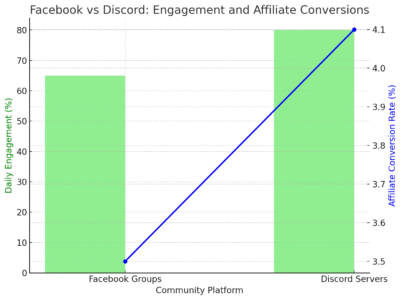
Choose a Specific Topic That Encourages Peer Help
The most active communities are built around specific challenges, goals, or interests. Instead of launching a broad “online business” group, go narrower—like “Email Marketing for Etsy Sellers” or “Freelance Designers Using Notion.”
Why this works:
- A focused group attracts members with shared pain points.
- It sparks real conversations, not just passive scrolling.
- You naturally position affiliate tools as part of the solution.
The most successful groups I’ve joined had names and taglines that clearly spelled out their purpose. It’s the clarity that makes people hit “Join.”
Share Tools, Tips, and Affiliate Links With Context
Once your group is active, it becomes the perfect place to share recommendations. But the key is adding real context—what the tool does, how you use it, and why it’s worth checking out.
Try these approaches:
- Post a weekly “Tools I Used This Week” thread with your affiliate links and notes.
- Answer member questions with genuine recommendations (and include your link where relevant).
- Pin a “Start Here” guide with links to your top-reviewed products.
You don’t need to push. People are more likely to click your link if they’ve already seen you using or explaining the tool in action.
Engage Daily to Build Trust and Authority
If you’re serious about growing a community, daily interaction makes all the difference. That doesn’t mean writing essays every day—but it does mean showing up.
Here’s what you can do:
- Welcome new members with a tag and a question to break the ice.
- Reply quickly to comments to keep discussions going.
- Share behind-the-scenes posts or quick wins from your own workflow.
The chart above shows that Discord tends to drive slightly higher engagement and conversion rates than Facebook, likely because of its real-time, organized structure. But both can work incredibly well if you’re consistent.
Promote Exclusive Offers Only Available to Group Members
One of the easiest ways to boost affiliate conversions is to make your group feel like a VIP space. When people know they’ll get early access or better deals by being in your community, they pay more attention.
Ways to offer exclusivity:
- Partner with affiliate programs to offer custom coupon codes for your group.
- Launch time-sensitive flash deals only inside the group.
- Share extra bonuses (like templates or mini-guides) available only to members who purchase through your link.
This approach rewards your most engaged members and gives them a reason to stick around.
Use SEO-Optimized Product Roundups and Reviews
Product roundups and reviews are some of the highest-converting content types in affiliate marketing. When done right, they can bring consistent search traffic and steady commissions—without a single ad.
Write Authentic Reviews Based on Real User Experience
Generic reviews don’t build trust. If you haven’t tried the product yourself, your review should at least reflect real use cases and tested insights.
What I’ve found most effective:
- Use screenshots, photos, or videos showing the product in use.
- Share what surprised you—both good and bad.
- Be honest about who it’s not a good fit for.
Readers can tell when you’re being sincere. That’s what builds long-term credibility—and repeat clicks.
Compare Similar Products to Help Readers Decide
Comparison posts are gold. They’re perfect for keywords like “X vs Y” or “Best tools for remote teams.” And they naturally lend themselves to multiple affiliate links.
To make your comparison useful:
- Create side-by-side feature tables.
- Include real-world examples of when each product works best.
- Explain what you’d choose—and why.
People love clear direction. Help them make a decision and they’ll thank you with a click.
Include Pros, Cons, and Use Cases for Transparency
One of the easiest ways to improve your affiliate reviews is to balance them. Include both the strengths and weaknesses of the product. Readers appreciate the honesty, and it sets your review apart from those just trying to sell.
Structure ideas:
- Who it’s for (and not for)
- What’s great
- What could be better
- Pricing breakdowns
Think of your content as a buyer’s assistant—not a sales pitch.
Monetize With Multiple Affiliate Programs Strategically
Relying on just one affiliate link per post is a missed opportunity. Different readers will resonate with different products, so it’s smart to include multiple affiliate options.
Here’s what works:
- Link to the same product on different platforms (Amazon, Walmart, Aliexpress, etc.).
- Include alternative tools for different budgets.
- Test different partners to see who converts best—some offer higher commissions or better cookie windows.
By spreading your monetization, you lower risk and increase your earning potential.
Create Free Courses or Webinars That Teach and Convert
Free educational content—like courses or webinars—is an underrated powerhouse for affiliate marketing. It gives you time to build trust and naturally introduce the tools or products that help solve your audience’s problems.
Build Mini-Courses Around Your Affiliate Products
Mini-courses are easier to produce than full courses and offer immediate value. Choose a specific transformation—like setting up a blog, creating a digital planner, or editing a YouTube video—and build your lessons around the tools you use.
Tips for structuring a mini-course:
- Break it into 3–5 short lessons (video or email-based).
- Introduce a tool naturally in each step.
- Offer your affiliate link as a “what I use” recommendation.
You don’t need a fancy platform. Gumroad, Teachable, or even a simple Notion guide works well for delivery.
Teach Real Use Cases and Offer Solutions
Generic tutorials don’t drive action. But when you walk through a real problem and solve it using your affiliate product, the connection becomes obvious and compelling.
Examples:
- Show how you grew your email list with ActiveCampaign.
- Demonstrate how you automated content planning with Notion templates.
- Walk through publishing your first digital product using Gumroad.
It’s not about selling—it’s about teaching with purpose.
Embed Affiliate Links Naturally Into Lessons
The key is to avoid turning your course into a promo. Instead, drop your affiliate links only where they make sense and always frame them as “what I personally use” or “recommended resource.”
What I suggest:
- Use a simple resources list or “toolbox” section in each lesson.
- Mention the link in passing during a screen share or demo.
- Add a link roundup at the end of the course for easy access.
Promote via Email, Social, and SEO-Optimized Landing Pages
Once your course is ready, don’t let it sit in silence. Create a landing page that clearly explains what the course helps people achieve, then drive traffic using your email list, YouTube channel, or Pinterest account.
Effective promotion tactics:
- Share testimonials or screenshots from early students.
- Write blog posts that rank for related keywords and link to your course.
- Run a short email campaign to your list with a time-based offer or bonus.
Free courses deliver value upfront—and when you pair that with trusted affiliate recommendations, the results can be long-lasting and powerful.
Repurpose Content Across Multiple Free Platforms
Repurposing your content helps you stretch your efforts further while reaching new audiences. It’s one of the smartest ways to do affiliate marketing without starting from scratch each time.
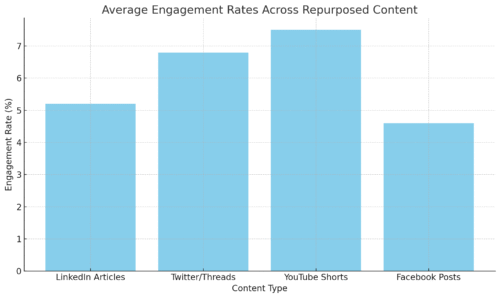
Turn Blog Posts Into LinkedIn Articles and Slides
If you’ve already written a valuable blog post, you don’t need to stop there. LinkedIn is a great place to share parts of your content in a more professional tone. It also gives you the chance to reach a completely different audience—especially in B2B or service-based niches.
Here’s how to do it:
- Pull out a few key takeaways and turn them into a LinkedIn article.
- Break down the post into slides using Canva or PowerPoint and publish them as a carousel.
- Add a simple CTA in your article or caption that points readers to your affiliate resource or original blog.
You’re not duplicating—you’re reinforcing your message in a new format.
Extract Tips for Twitter, Threads, or Facebook Posts
Short-form content makes your ideas more digestible. Platforms like Twitter and Threads are great for sharing bite-sized value and sparking curiosity.
You can extract:
- List-style tweets from blog posts (e.g., “7 tools I used to grow my email list”).
- Quick wins, quotes, or stats pulled from case studies.
- Behind-the-scenes thoughts or product comparisons based on your affiliate content.
The key is to share value first—then follow up with a subtle mention or link. On Facebook, you can even write long-form posts that feel like mini-blogs, which often convert surprisingly well.
Convert Tutorials Into Short Reels or YouTube Shorts
Video is everywhere, and short-form videos are getting serious reach. If you have a tutorial or guide, consider breaking it into 15–60 second clips.
Here’s how:
- Highlight one tip or step in each video.
- Use captions to make it accessible without sound.
- Mention the product briefly and add the affiliate link in your profile or pinned comment.
The chart above shows average engagement rates across content types, and short videos tend to outperform others because they’re easier to consume—and more likely to be shared.
Create a Content Flywheel That Points to Affiliate Offers
Once you have all this repurposed content, the goal is to connect it into a flywheel. Each piece should lead the viewer to the next step—whether that’s a blog post, email list, or product page.
Example content flow:
- Twitter thread → leads to blog post.
- Blog post → includes affiliate links and email opt-in.
- Email list → shares bonus tips and exclusive affiliate deals.
This kind of ecosystem builds trust and naturally introduces affiliate offers—without ever feeling forced.
Write for Other Blogs and Get Featured With Links
Writing guest posts for established blogs is a proven way to build authority, get high-quality backlinks, and attract targeted traffic to your affiliate content. It’s a win-win when done with care and strategy.
Pitch Guest Posts That Align With Affiliate Offers
Before you send a pitch, take time to research blogs that match your audience and niche. Then, think about topics that blend value and your affiliate product naturally.
What works well:
- A how-to tutorial that solves a problem using the product.
- A comparison post that includes your affiliate pick.
- A personal case study that highlights a transformation.
Make sure your post idea helps the blog’s audience first—your affiliate links are just a bonus.
Add Contextual Affiliate Links Where Allowed
Not all blogs will let you add affiliate links in the body of the post. But when they do, it’s best to use them sparingly and with full transparency.
Tips for using affiliate links in guest content:
- Link to a blog post on your own site that contains the affiliate offer.
- Mention your experience using the tool, then offer it as a suggestion.
- Use natural anchor text—never force it in.
When affiliate links aren’t allowed, you can still create value and link to your own resources where the offer is featured.
Use Author Bio to Link Back to Your Site or Newsletter
Your author bio is prime space. If the site doesn’t allow direct affiliate links, use the bio to bring readers to your own platform.
Ideas to include:
- A link to your free guide or mini-course.
- A simple landing page where you explain the tools you recommend.
- Your newsletter opt-in with a clear benefit.
This builds your audience and gives you the freedom to promote affiliate offers on your own terms.
Choose Blogs With Engaged Audiences and Real Traffic
Not all guest posting opportunities are equal. Prioritize blogs that:
- Get consistent traffic from search or social.
- Have active comment sections or community engagement.
- Serve a niche that overlaps with your affiliate content.
You can use tools like SimilarWeb or Ahrefs to check traffic levels, or just look at their social engagement as a sign of life. Writing for five high-quality blogs is worth more than fifty low-traffic ones.
Focus on Building Long-Term Trust and Authority
The truth is, people don’t buy from strangers—they buy from people they trust. That’s why long-term success in affiliate marketing comes from building real authority, not short-term tricks.
Be Transparent About Affiliate Relationships
Let people know you’re using affiliate links. This isn’t just about legal compliance—it’s about being upfront and honest. When you explain that you only recommend tools you believe in, most readers respect that.
You can say things like:
- “This is an affiliate link, which means I may earn a small commission.”
- “I’ve tested this myself and only recommend what’s helped me.”
Transparency builds loyalty, and loyal readers click more often.
Share Personal Stories and Lessons Learned
Affiliate content doesn’t have to feel robotic. In fact, when you open up about what worked, what didn’t, and what surprised you, it helps readers connect with your message.
Try this:
- Write a “What I wish I knew before using [tool]” post.
- Share results you’ve had using a product, both good and bad.
- Include screenshots, charts, or timelines to bring your story to life.
Your real-world perspective is what sets your content apart.
Provide Unbiased Recommendations and Alternatives
Sometimes the best way to sell is to also show what not to buy. If your entire site reads like a string of promotions, readers tune out. But if you include real pros, cons, and alternatives, they’re more likely to trust your final recommendation.
Ways to do this:
- Compare 3–4 tools side by side, even if you only promote one.
- Offer free and paid options for different budgets.
- List when a tool might not be worth it—for example, if a free alternative exists.
Your goal is to help the reader—not just push a product.
Engage With Your Audience Through Comments and Replies
Whether it’s on your blog, YouTube channel, email replies, or social posts, showing up in the comments builds community and trust.
What you can do:
- Answer questions with thoughtful replies.
- Thank people for sharing feedback or wins.
- Offer to help troubleshoot or clarify things.
It shows that you’re more than a marketer—you’re someone who cares. And over time, that builds the kind of trust that no ad budget can buy.



